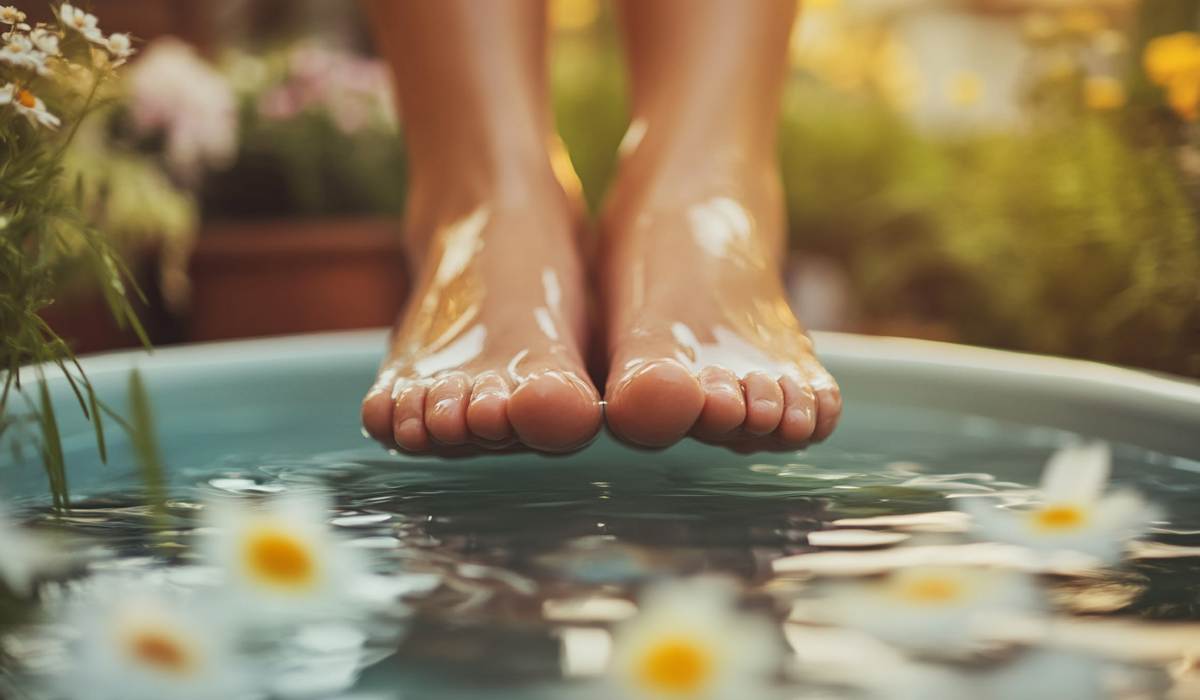11 Soothing Foot Soak Recipes (DIY). Ideas to Pamper Your Feet at Home!
Who needs an expensive spa day when you can pamper your hardworking feet right at home?
Welcome to your DIY foot soak adventure. Think you’re about to transform your bathroom into a personal oasis of relaxation…. oh, yes.
Forget shelling out big bucks for fancy foot treatments – the below homemade foot soaks will have your toes tingling with joy. Lovely.
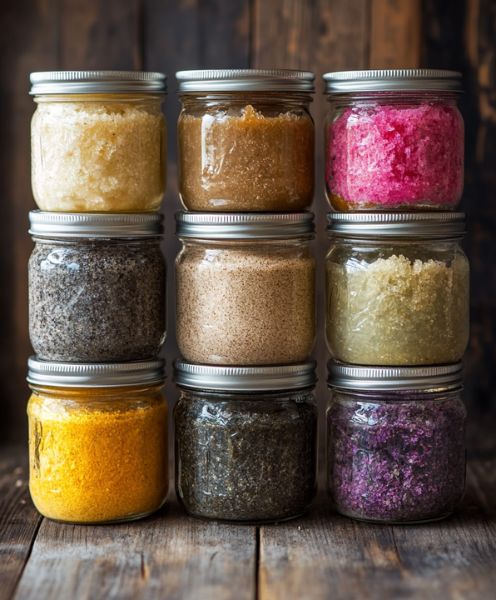
In this guide, I will show you 11 soothing foot soak recipes that’ll make you wonder why you ever considered paying for a pedicure. From the classic Epsom salt soak to more exotic ones like the green tea antioxidant bath, I belive I’ve got a recipe for every mood you could possibly be in.

Also, you probably have most of these ingredients in your kitchen cupboards already (hopefully!). So, those essential oils gathering dust on your shelf are going to be working for your feet.
Grab a basin, raid your pantry, and let’s make those feet of yours a little happier today.

Foot soak benefits
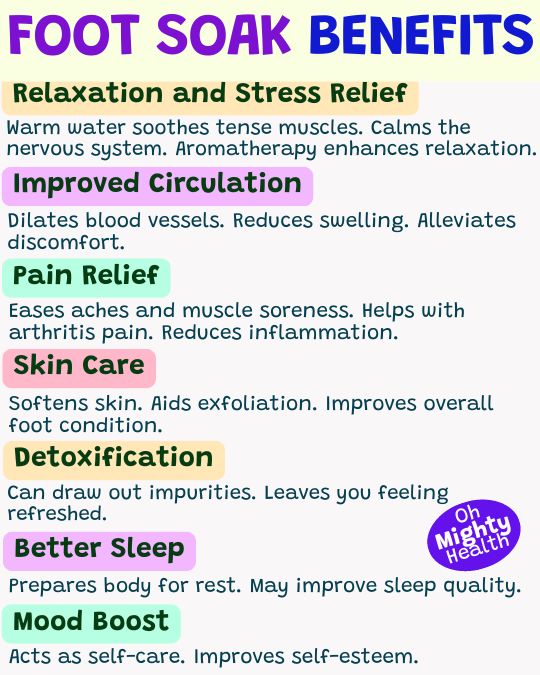
Here’s why you should consider making foot soaks a regular part of your self-care routine:
1. Relaxation and Stress Relief:
Immersing your feet in warm water naturally encourages relaxation. The warmth helps to soothe tense muscles and calm your nervous system, promoting a sense of overall well-being.
2. Improved Circulation:
The warm water of a foot soak helps to dilate blood vessels, improving circulation in your feet and lower legs. This increased blood flow can help reduce swelling and alleviate discomfort, particularly beneficial for those who spend long hours on their feet.
3. Pain Relief and Muscle Relaxation:
For individuals suffering from foot pain, arthritis, or muscle soreness, foot soaks can provide significant relief. The combination of warm water and specific ingredients like Epsom salts can help to ease aches and pains, reducing inflammation and promoting healing.
4. Skin Softening and Exfoliation:
Regular foot soaks can dramatically improve the condition of your skin. The warm water softens the skin, making it more receptive to moisturisers and treatments. Many foot soak recipes include natural exfoliants that help to slough off dead skin cells, leaving your feet feeling soft and smooth.
5. Detoxification:
While the concept of ‘detoxification’ through the feet is debated in scientific circles, many people report feeling refreshed and rejuvenated after a foot soak. Certain ingredients (i.e. Epsom salts and activated charcoal) are believed to draw out impurities from the body.
6. Enhanced Sleep Quality:
A relaxing foot soak before bedtime can help prepare your body for sleep. The process of warming your feet and then allowing them to cool can signal to your body that it’s time to rest, potentially improving your sleep quality.
7. Mood Enhancement:
The act of self-care itself can boost your mood and self-esteem. Taking time out of your day to pamper yourself sends a powerful message of self-love and can significantly improve your overall outlook.
Foot soak ingredients (start building your arsenal!)

Common base ingredients
Epsom Salt (Magnesium Sulphate):
- Benefits: Reduces inflammation, eases muscle soreness, improves circulation
- Usage: Add 1/2 to 1 cup per foot bath
Sea Salt:
- Benefits: Rich in minerals, exfoliates, softens skin
- Usage: Use 1/4 to 1/2 cup per foot bath
Baking Soda (Sodium Bicarbonate):
- Benefits: Softens skin, neutralises odours, helps balance pH
- Usage: Add 1/4 to 1/2 cup per foot bath
Essential oils and their properties
When using essential oils, always dilute properly and perform a patch test first. Here are some beneficial oils for foot soaks:
Lavender:
- Properties: Relaxing, anti-inflammatory, antimicrobial
- Usage: 5-10 drops per foot bath
Peppermint:
- Properties: Cooling, invigorating, aids circulation
- Usage: 3-5 drops per foot bath
Tea Tree:
- Properties: Antifungal, antibacterial, deodorising
- Usage: 5-7 drops per foot bath
Eucalyptus:
- Properties: Decongestant, anti-inflammatory, refreshing
- Usage: 5-7 drops per foot bath
Rosemary:
- Properties: Stimulating, improves circulation, eases muscle pain
- Usage: 5-7 drops per foot bath
Natural additives
Dried Herbs and Flowers:
- Options: Chamomile, rose petals, calendula
- Benefits: Add natural fragrance and skin-soothing properties
- Usage: 1-2 tablespoons per foot bath
Oatmeal:
- Benefits: Soothes irritated skin, moisturises
- Usage: 1/4 cup of finely ground oats per foot bath
Citrus Fruits:
- Options: Lemon, orange, grapefruit slices
- Benefits: Refreshing, astringent, vitamin C boost for skin
- Usage: Slices from half a fruit per foot bath
Household items with foot care benefits
Apple Cider Vinegar:
- Benefits: Balances pH, fights foot odour and fungus
- Usage: 1/2 cup per foot bath
Green Tea Bags:
- Benefits: Antioxidant, reduces inflammation
- Usage: 3-4 tea bags steeped in foot bath water
Plant Milk:
- Benefits: Softens skin, soothing and moisturising due to its natural oils, vitamins, and other nutrients
- Usage: 1-2 cups per foot bath
Coconut Oil:
- Benefits: Moisturises, has antimicrobial properties
- Usage: 1-2 tablespoons melted into warm foot bath
When combining ingredients, consider their properties and how they complement each other.
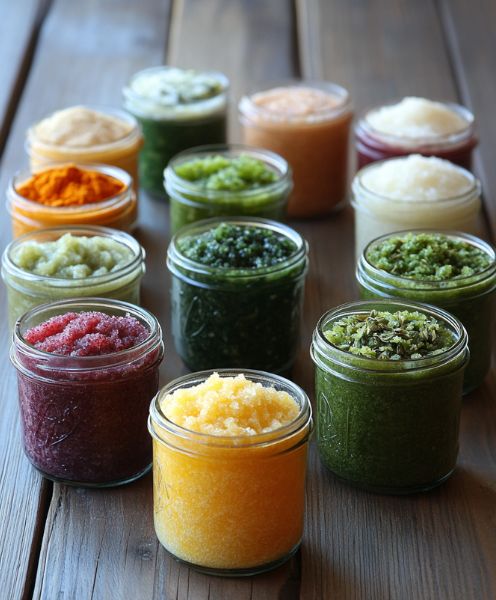
For example, a relaxing foot soak might combine Epsom salt, lavender essential oil, and dried chamomile flowers.
For a refreshing, deodorising soak, you might use sea salt, tea tree oil, and apple cider vinegar.
Remember, quality matters when it comes to ingredients! Go for pure, organic components whenever possible to ensure the best results and to avoid any potential skin irritations from additives or synthetic materials.
In the next section, we’ll explore how to combine these wonderful ingredients into effective DIY foot soak recipes.
DIY recipes: 10 soothing foot soak ideas
1. Classic epsom salt soak
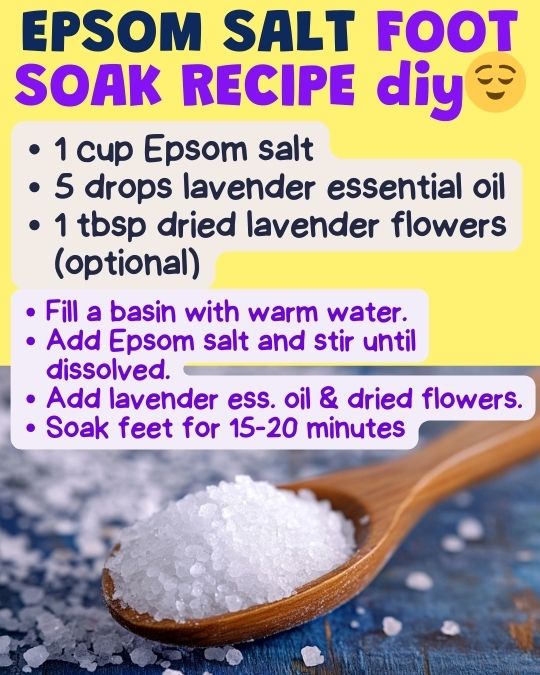
The Epsom salt foot soak is a timeless remedy, beloved for its simplicity and effectiveness. This recipe harnesses the power of magnesium-rich Epsom salt, combined with the calming essence of lavender, to create a truly restorative experience.
Ingredients:
- 1 cup Epsom salt
- 5 drops lavender essential oil
- 1 tablespoon dried lavender flowers (optional)
Instructions: Begin by filling a basin with warm water, ensuring it’s comfortable to the touch. Dissolve the Epsom salt in the water, stirring gently to ensure even distribution. Add the lavender essential oil, allowing its soothing aroma to permeate the air. If you’re using dried lavender flowers, sprinkle them on the water’s surface for an extra touch of luxury.
Immerse your feet in this calming bath for 15-20 minutes. As you soak, you’ll feel tension melting away. The magnesium from the Epsom salt works to relax muscles and reduce inflammation, while the lavender promotes a sense of calm and well-being.
After your soak, gently pat your feet dry and follow up with a nourishing foot cream to lock in the benefits.
2. Lavender and chamomile relaxation soak
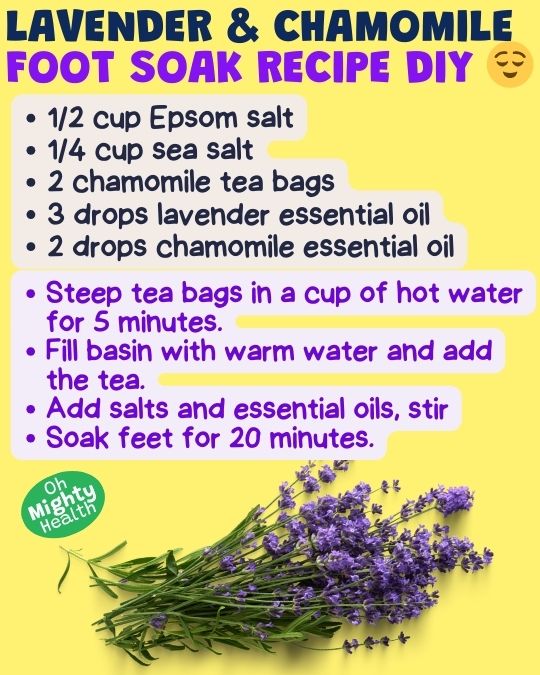
This recipe combines two of nature’s most renowned relaxants: lavender and chamomile. It’s the perfect remedy for those days when you need to unwind and de-stress from head to toe.
Ingredients:
- 1/2 cup Epsom salt
- 1/4 cup sea salt
- 2 chamomile tea bags
- 3 drops lavender essential oil
- 2 drops chamomile essential oil
Instructions: Start by steeping the chamomile tea bags in a cup of hot water for 5 minutes. While the tea is brewing, fill your foot basin with comfortably warm water. Once steeped, add the tea to your foot bath, bringing with it the gentle, apple-like scent of chamomile.
Next, add the Epsom salt and sea salt, stirring until fully dissolved. These salts work in tandem to soften skin and ease muscle tension. Finally, add the lavender and chamomile essential oils, dropping them directly into the water and swirling gently to disperse.
Soak your feet in this aromatic bath for 20 minutes. As you relax, visualise the day’s stresses flowing out through your feet. The combination of lavender and chamomile works to calm the mind and soothe the senses, promoting deep relaxation.
After your soak, wrap your feet in a soft towel and take a few moments to enjoy the lingering sense of tranquillity before moisturising.
3. Peppermint refresher soak
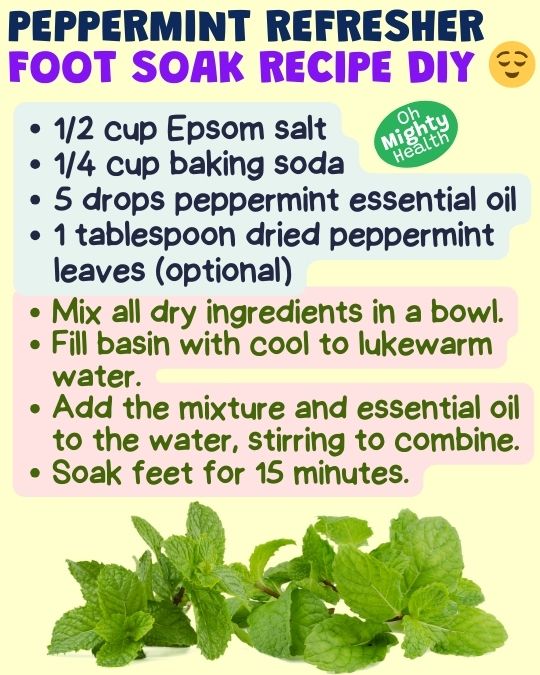
When your feet need a pick-me-up, this invigorating peppermint soak is just the ticket. It’s particularly beneficial after a long day on your feet or as a refreshing treat in warm weather.
Ingredients:
- 1/2 cup Epsom salt
- 1/4 cup baking soda
- 5 drops peppermint essential oil
- 1 tablespoon dried peppermint leaves (optional)
Instructions: In a bowl, mix the Epsom salt and baking soda. This dynamic duo helps to soften skin, reduce inflammation, and neutralise odours. Fill your foot basin with cool to lukewarm water – the cooler temperature enhances peppermint’s refreshing qualities.
Add the salt and baking soda mixture to the water, stirring to dissolve. Then, drop in the peppermint essential oil. As you add the oil, you’ll notice the crisp, minty aroma beginning to fill the air. If you’re using dried peppermint leaves, sprinkle them on the water’s surface for an extra burst of natural mint.
Submerge your feet in this revitalising bath for 15 minutes. The cool water and peppermint work together to invigorate tired feet, improve circulation, and leave you feeling refreshed. The tingling sensation of the peppermint can be especially soothing for hot, swollen feet.
After soaking, dry your feet thoroughly and follow up with a cooling foot lotion to prolong the refreshing effects.
4. Tea tree and eucalyptus detox soak
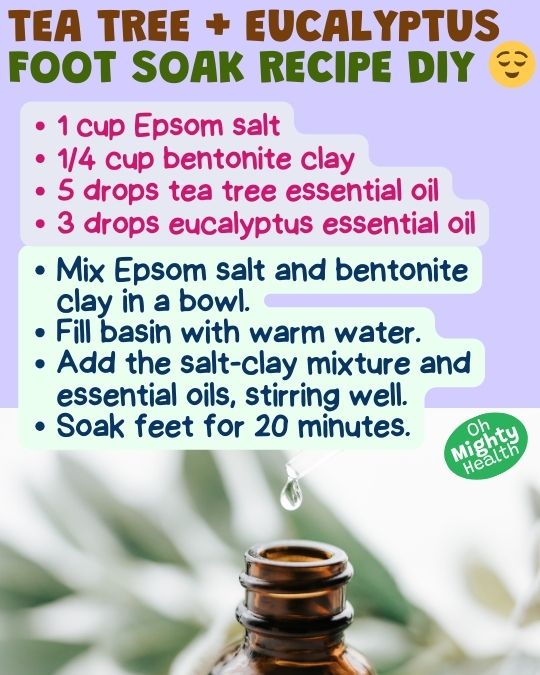
This powerful combination of tea tree and eucalyptus oils creates a foot soak that’s both cleansing and invigorating. It’s particularly beneficial for those dealing with foot odour, athlete’s foot, or general foot fatigue.
Ingredients:
- 1 cup Epsom salt
- 1/4 cup bentonite clay
- 5 drops tea tree essential oil
- 3 drops eucalyptus essential oil
Instructions: Begin by mixing the Epsom salt and bentonite clay in a bowl. The Epsom salt helps to draw out toxins, while bentonite clay is known for its ability to absorb impurities from the skin.
Fill your foot basin with comfortably warm water. Gradually add the salt and clay mixture, stirring continuously to ensure it dissolves and disperses evenly. Next, add the tea tree and eucalyptus essential oils, swirling the water gently to distribute them.
Immerse your feet in this purifying bath for 20 minutes. As you soak, you may feel a slight tingling sensation – this is the active properties of the essential oils working their magic. Tea tree oil is renowned for its antifungal and antibacterial properties, making it excellent for combating foot odour and fungal infections. Eucalyptus adds a refreshing scent while also helping to soothe tired muscles.
After soaking, rinse your feet with clean water and dry thoroughly, paying special attention to the areas between your toes. Follow up with a tea tree oil-infused foot cream for continued protection.
5. Lemon and baking soda exfoliating soak
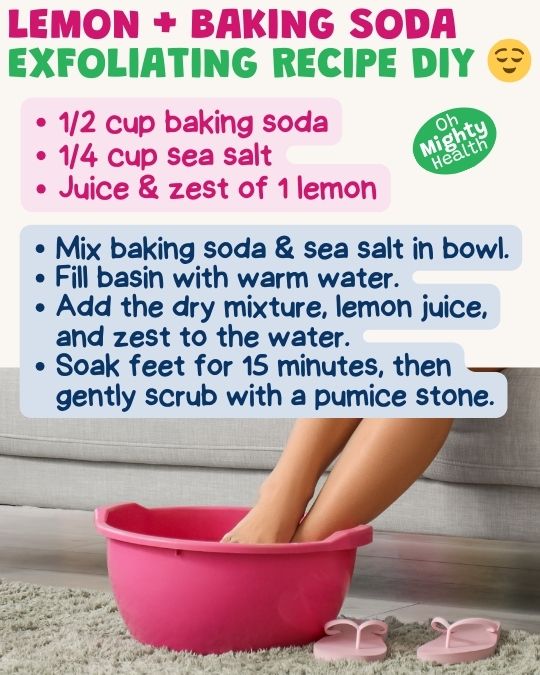
This zesty foot soak is a natural exfoliant, perfect for sloughing away dead skin and leaving your feet feeling soft and refreshed. It’s ideal for tackling rough, callused areas and brightening dull skin.
Ingredients:
- 1/2 cup baking soda
- 1/4 cup sea salt
- Juice of 1 lemon
- Zest of 1 lemon
Instructions: In a bowl, combine the baking soda and sea salt. These natural exfoliants work together to soften and remove dead skin cells gently. Fill your foot basin with warm water, then add the dry mixture, stirring until it’s fully dissolved.
Squeeze the juice of one lemon into the water. Lemon juice is naturally acidic, which helps to break down dead skin cells and leaves feet feeling fresh. Add the lemon zest as well – not only does it provide a wonderful citrusy aroma, but the oils in the zest also have cleansing and brightening properties.
Soak your feet in this invigorating mixture for 15 minutes. The combination of the granular salt and baking soda with the acidic lemon creates a gentle yet effective exfoliating action. After soaking, use a pumice stone or foot scrubber to gently remove any loosened dead skin, paying extra attention to rough areas like heels and the balls of your feet.
Rinse your feet with clean water and pat them dry. Follow up with a rich, moisturising foot cream to nourish your newly smoothed skin.
6. Apple cider vinegar foot odour eliminator
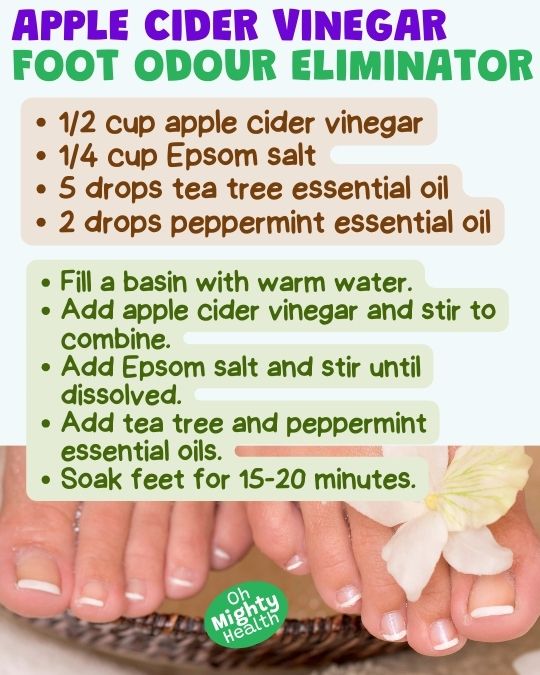
If foot odour is a concern, this apple cider vinegar soak can be a game-changer. It helps to balance the pH of your feet, creating an environment less hospitable to odour-causing bacteria.
Ingredients:
- 1/2 cup apple cider vinegar
- 1/4 cup Epsom salt
- 5 drops tea tree essential oil
- 2 drops peppermint essential oil
Instructions: Fill your foot basin with warm water. Add the apple cider vinegar, stirring to combine. Don’t worry about the vinegar smell – it will dissipate as the soak progresses and will be masked by the essential oils.
Add the Epsom salt to the mixture, stirring until it’s fully dissolved. The salt helps to draw out impurities and soften the skin. Next, add the tea tree and peppermint essential oils. Tea tree oil is a powerful natural antimicrobial, while peppermint adds a fresh scent and helps to cool and invigorate tired feet.
Soak your feet in this solution for 15-20 minutes. The acidity of the apple cider vinegar works to rebalance the pH of your feet, making it difficult for odour-causing bacteria to thrive. Meanwhile, the essential oils provide additional antibacterial support and leave your feet smelling fresh.
After soaking, rinse your feet with clean water and dry them thoroughly, especially between the toes. For best results, follow up with an antibacterial foot powder or a few drops of tea tree oil mixed with a carrier oil like coconut oil.
7. Green tea antioxidant soak
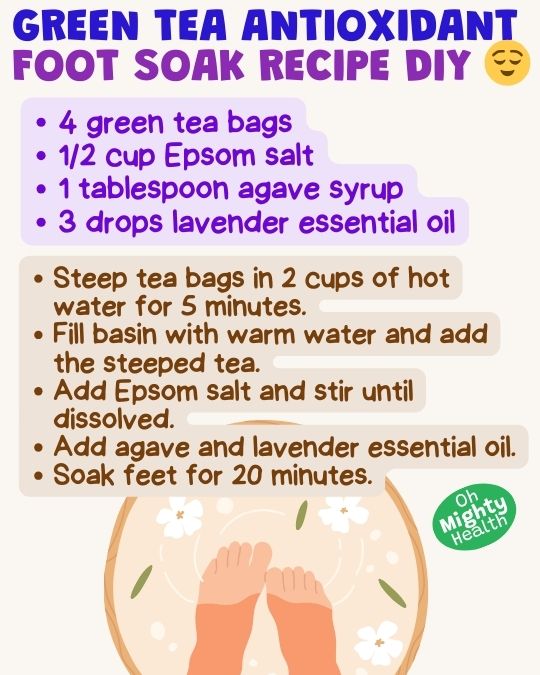
Harness the power of green tea’s antioxidants with this soothing and rejuvenating foot soak. It’s perfect for revitalising tired feet and promoting overall foot health.
Ingredients:
- 4 green tea bags
- 1/2 cup Epsom salt
- 1 tablespoon agave syrup
- 3 drops lavender essential oil
Instructions: Begin by steeping the green tea bags in 2 cups of hot water for about 5 minutes. While the tea is brewing, fill your foot basin with warm water. Once steeped, remove the tea bags and pour the green tea into your foot bath.
Add the Epsom salt to the water, stirring until it’s fully dissolved. The combination of green tea and Epsom salt creates a mineral-rich soak that helps to draw out impurities and reduce inflammation.
Next, add the agave to the mixture. Finally, add the lavender essential oil, swirling the water gently to disperse it. The lavender adds a calming aroma and helps to soothe any skin irritations.
Soak your feet in this nourishing bath for 20 minutes. As you relax, visualise the antioxidants from the green tea penetrating your skin, neutralising free radicals and promoting cellular health. The Epsom salt works to ease any muscle tension, while the agave and lavender leave your skin feeling soft and soothed.
After soaking, gently pat your feet dry and follow up with a light, non-greasy moisturiser to lock in the benefits of your antioxidant soak.
8. Rosemary and Sea Salt Circulation Booster
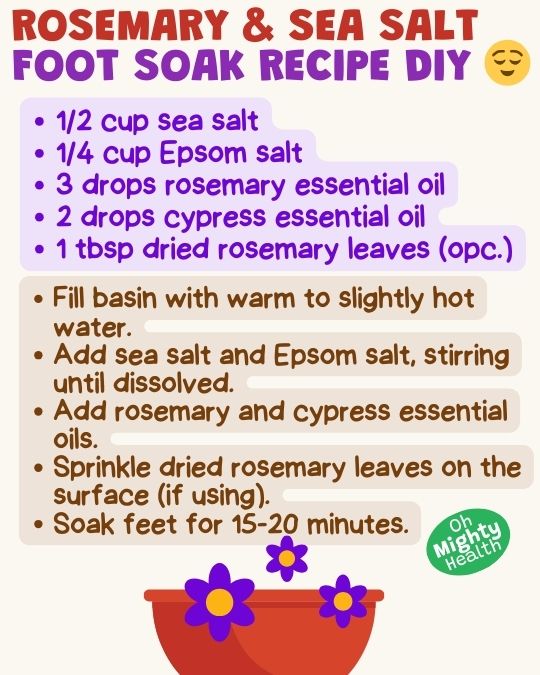
This invigorating soak is designed to stimulate circulation and rejuvenate tired, achy feet. It’s particularly beneficial for those who spend long hours standing or for anyone looking to give their feet an energizing boost.
Ingredients:
- 1/2 cup sea salt
- 1/4 cup Epsom salt
- 3 drops rosemary essential oil
- 2 drops cypress essential oil
- 1 tablespoon dried rosemary leaves (optional)
Instructions: Start by filling your foot basin with warm to slightly hot water. The warmth of the water will help to dilate blood vessels and improve circulation.
Add both the sea salt and Epsom salt to the water, stirring until fully dissolved. Sea salt is rich in minerals that can be absorbed through the skin, while Epsom salt helps to reduce inflammation and ease muscle tension.
Next, add the rosemary and cypress essential oils. Rosemary is known for its ability to stimulate circulation and reduce muscle pain, while cypress oil can help to improve blood flow and reduce fluid retention.
If you’re using dried rosemary leaves, sprinkle them on the surface of the water. As you soak, the warm water will release the aromatic compounds in the rosemary, enhancing the circulatory benefits and creating a spa-like atmosphere.
Immerse your feet in this revitalizing bath for 15-20 minutes. You may feel a gentle tingling sensation as the circulation in your feet improves. The combination of warm water, mineral-rich salts, and stimulating essential oils works to invigorate tired feet and legs.
For an extra boost to circulation, consider alternating between this warm foot soak and a cool water rinse. This contrast therapy can further stimulate blood flow and leave your feet feeling refreshed and energized.
After soaking, dry your feet thoroughly and massage them gently, working from the toes up towards the ankles to encourage blood flow. Follow up with a cooling gel or lotion containing menthol or peppermint for an extra refreshing finish.
These ten foot soak recipes offer a variety of benefits, from relaxation and moisturising to detoxification and improved circulation. Remember to always patch test new ingredients and consult with a healthcare professional if you have any underlying health conditions or concerns. Happy soaking!
Foot soak ideas for special occasions
While regular foot care is essential, there are times when you might want to elevate your foot soak experience for special occasions. Whether you’re planning a romantic evening, preparing for a big event, or simply want to treat yourself, these specialised foot soaks are designed to add an extra touch of luxury and care to your routine.
9. Romantic couple’s foot soak
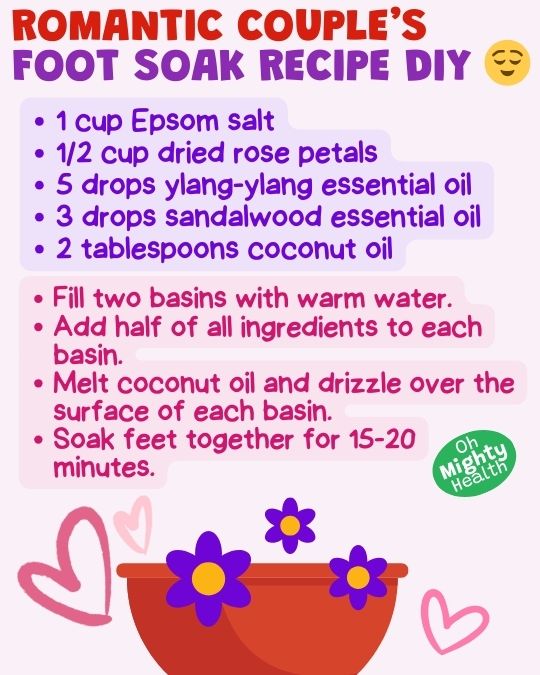
Transform your usual foot care routine into a bonding experience with this romantic couple’s foot soak. It’s perfect for date nights at home or as a relaxing prelude to a special evening out.
Ingredients:
- 1 cup Epsom salt
- 1/2 cup dried rose petals
- 5 drops ylang-ylang essential oil
- 3 drops sandalwood essential oil
- 2 tablespoons coconut oil
Instructions: Fill two basins with warm water. In each basin, add half of the Epsom salt, rose petals, and essential oils. The rose petals not only add a romantic touch but also have skin-softening properties. Ylang-ylang is known for its relaxing and mood-enhancing effects, while sandalwood adds a warm, sensual aroma.
Melt the coconut oil and drizzle it over the surface of the water in each basin. Coconut oil is deeply moisturising and leaves the skin feeling silky smooth.
Soak your feet together for 15-20 minutes, using this time to connect and relax. After soaking, gently massage each other’s feet with the remaining coconut oil for an extra indulgent experience.
10. Energising pre-event foot soak
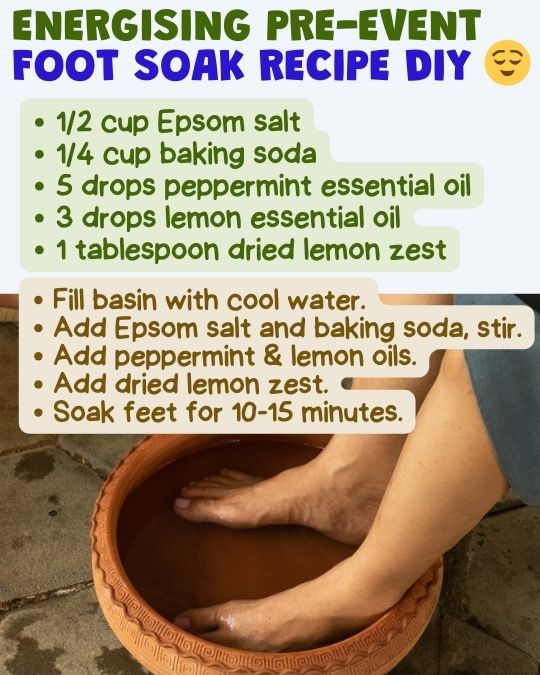
Before a big event where you’ll be on your feet for hours, try this invigorating foot soak. It’s designed to energize your feet and prepare them for the demands ahead.
Ingredients:
- 1/2 cup Epsom salt
- 1/4 cup baking soda
- 5 drops peppermint essential oil
- 3 drops lemon essential oil
- 1 tablespoon dried lemon zest
Instructions: Fill a basin with cool water. Add the Epsom salt and baking soda, stirring until dissolved. The cool water helps to reduce any swelling and tightens blood vessels, while the Epsom salt and baking soda work to soften the skin and neutralise odours.
Add the peppermint and lemon essential oils, along with the dried lemon zest. Peppermint oil provides a cooling sensation and helps to invigorate tired feet, while lemon oil adds a refreshing scent and has astringent properties.
Soak your feet for 10-15 minutes. The cool temperature and invigorating scents will help to wake up your feet and prepare them for the event ahead. After soaking, dry your feet thoroughly and apply a light, non-greasy foot cream.
11. Soothing post-workout foot soak
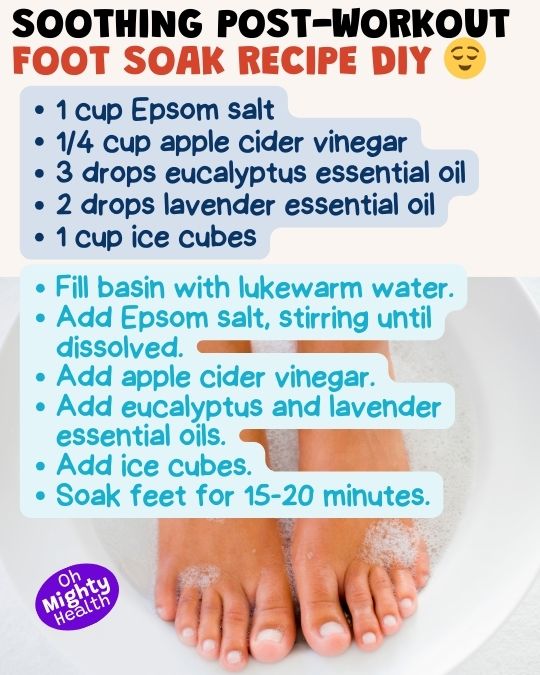
After an intense workout or a long run, treat your feet to this soothing soak. It’s designed to ease muscle soreness and reduce inflammation.
Ingredients:
- 1 cup Epsom salt
- 1/4 cup apple cider vinegar
- 3 drops eucalyptus essential oil
- 2 drops lavender essential oil
- 1 cup ice cubes
Instructions: Fill a basin with lukewarm water and add the Epsom salt, stirring until dissolved. The magnesium in Epsom salt helps to reduce muscle soreness and inflammation. Add the apple cider vinegar, which can help to balance pH levels and soothe any minor skin irritations.
Add the eucalyptus and lavender essential oils. Eucalyptus has anti-inflammatory properties and provides a cooling sensation, while lavender helps to relax tired muscles.
Finally, add the ice cubes to the water. This creates a contrast therapy effect – the lukewarm water helps to relax muscles, while the cold from the ice helps to reduce inflammation and numb any pain.
Soak your feet for 15-20 minutes, gently moving them around to circulate the water. After soaking, gently pat your feet dry and elevate them for a few minutes to further reduce any swelling.
These specialised foot soaks demonstrate how you can adapt your foot care routine to suit different occasions and needs.
Remember, the key to any effective foot soak is using quality ingredients and taking the time to truly relax and enjoy the experience.
Foot soak at home: essential tips

As a cosmetic organic formulator, I can attest that the key to an effective foot soak lies in the details.
Here are some essential tips to ensure you get the most out of your at-home foot soak experience:
- Ideal Water Temperature: The temperature of your foot soak is crucial for both comfort and efficacy. Aim for water that’s comfortably warm, typically between 35-38°C (95-100°F). This temperature range helps to relax muscles and open pores without causing discomfort or potential skin damage. If you don’t have a thermometer handy, the water should feel pleasantly warm, not hot, when you dip your elbow in it.
- Recommended Soak Duration: The ideal duration for a foot soak is typically 15-30 minutes. This timeframe allows for optimal absorption of beneficial ingredients and provides ample time for relaxation. Soaking for longer than 30 minutes may lead to skin maceration (over-softening), which can make your feet more susceptible to injury or infection.
- Best Time for a Foot Soak: While you can enjoy a foot soak at any time, certain periods can maximise its benefits:
- Evening: A soak before bedtime can help you relax and prepare for sleep.
- Post-workout: Soaking after exercise can aid in muscle recovery and reduce inflammation.
- After a long day: If you’ve been on your feet all day, an evening soak can provide much-needed relief.
- Preparation and Aftercare:
- Cleanse: Before soaking, wash your feet with mild soap to remove surface dirt and bacteria.
- Nail care: Trim your toenails before soaking to prevent them from becoming too soft.
- Exfoliation: Use a pumice stone or foot scrub after soaking when your skin is softened for easy dead skin removal.
- Moisturise: After patting your feet dry, apply a nourishing foot cream or oil to lock in moisture.
- Hydration: Remember to drink water before and after your soak to support your body’s natural detoxification processes.
- Container Considerations: Use a basin or tub that allows both feet to be comfortably submerged up to the ankles. Ensure it’s clean and made of a material that retains heat well, such as plastic or ceramic.
- Customisation: Don’t hesitate to adjust recipes to suit your needs. If you have sensitive skin, start with smaller amounts of active ingredients and gradually increase as tolerated.
- Frequency: For general maintenance, a weekly foot soak is beneficial. However, if you’re addressing specific foot issues or during periods of high stress, you might increase the frequency to 2-3 times a week.
- Mindfulness: Use this time not just for foot care, but as a moment of mindfulness. Focus on the sensations, breathe deeply, and allow yourself to fully relax into the experience.
By following these tips, you’ll create an optimal environment for your feet to soak in, ensuring maximum benefits from your chosen recipe. Remember, consistency is key in foot care, so try to make foot soaks a regular part of your self-care routine.
Safety considerations and precautions
While foot soaks are generally safe and beneficial, it’s important to keep certain precautions in mind to ensure a positive and healthy experience. As a cosmetic organic formulator, I always emphasize the importance of safety alongside efficacy. Here are some key considerations to keep in mind:
When to avoid foot soaks
- Open Wounds or Infections: If you have any cuts, blisters, or active infections on your feet, it’s best to avoid foot soaks until these have healed. Soaking could introduce bacteria into the wound or exacerbate existing infections.
- Diabetic Foot Conditions: If you have diabetes, consult with your healthcare provider before starting a foot soak routine. Diabetes can affect circulation and sensation in the feet, making them more susceptible to injury.
- Severe Varicose Veins: For individuals with severe varicose veins, prolonged soaking in warm water might exacerbate swelling and discomfort. Consult with a healthcare professional for personalized advice.
- Pregnancy: While many foot soaks are safe during pregnancy, it’s best to consult with your obstetrician, especially regarding the use of essential oils.
Allergies and sensitivities
- Patch Testing: Before using any new ingredient in your foot soak, especially essential oils, perform a patch test. Apply a small amount of the diluted ingredient to the inside of your wrist and wait 24 hours to check for any adverse reactions.
- Essential Oil Safety: Essential oils are potent and should always be used in moderation. Never apply them directly to the skin without proper dilution. If you’re pregnant, have sensitive skin, or have any health conditions, consult with a healthcare provider before using essential oils.
- Natural Doesn’t Always Mean Safe: Remember that even natural ingredients can cause allergic reactions or irritation in some individuals. Always start with smaller amounts of new ingredients and observe how your skin reacts.
Proper hygiene practices
- Clean Equipment: Always use a clean basin for your foot soaks. After each use, wash the basin thoroughly with soap and warm water, and dry it completely to prevent the growth of mould or bacteria.
- Water Temperature: Ensure the water is at a comfortable temperature. Water that’s too hot can cause burns or damage to the skin. Use a thermometer if needed, aiming for a temperature between 36°C to 38°C (96.8°F to 100.4°F).
- Soak Duration: Limit your foot soaks to 15-20 minutes. Soaking for too long can lead to skin maceration (over-softening), which can make your feet more susceptible to injury or infection.
- Drying Thoroughly: After your foot soak, dry your feet completely, paying special attention to the areas between your toes. This helps prevent fungal growth.
Additional tips
- Hydration: Remember to drink water before and after your foot soak, especially if you’re using Epsom salts, which can have a mild diuretic effect.
- Moisturize: After drying your feet, apply a good quality moisturizer to lock in hydration and keep your skin soft.
- Nail Care: If you have any nail conditions, such as ingrown toenails or fungal infections, consult with a podiatrist before starting a foot soak routine.
- Frequency: While foot soaks can be beneficial, doing them too frequently might dry out your skin. For most people, 1-2 times a week is sufficient.
By keeping these safety considerations and precautions in mind, you can ensure that your foot soak experience is not only enjoyable but also safe and beneficial for your overall foot health. Remember, when in doubt, it’s always best to consult with a healthcare professional, especially if you have any underlying health conditions or concerns.
Conclusion
As we’ve explored throughout this article, foot soaks are more than just a luxurious treat—they’re a valuable component of a comprehensive foot care routine. From relaxation and stress relief to addressing specific foot concerns, the humble foot soak offers a wide array of benefits that can significantly improve your overall foot health and well-being.
We’ve journeyed through the science behind foot soaks, discovering how different ingredients work together to nourish, soothe, and revitalize our hardworking feet. We’ve explored a variety of recipes, each tailored to address specific needs—from the classic Epsom salt soak for general relaxation to more specialized formulations for issues like foot odour or dry skin.
The beauty of DIY foot soaks lies in their versatility and accessibility. With common household ingredients and a few high-quality essential oils, you can create spa-worthy treatments in the comfort of your own home. This not only saves money but also allows you to customise your foot care routine to your specific needs and preferences.
Remember, consistency is key when it comes to foot care. While an occasional foot soak can provide immediate relief and relaxation, incorporating regular foot soaks into your self-care routine can lead to long-term improvements in foot health. Whether it’s a weekly relaxation ritual or a targeted treatment for specific foot issues, make foot soaks a regular part of your wellness routine.
As you experiment with different recipes and find your favourites, don’t be afraid to get creative. The recipes provided in this article are excellent starting points, but feel free to adjust and personalize them to suit your needs. Always keep safety in mind, particularly when working with new ingredients or essential oils, and consult with a healthcare professional if you have any concerns.
Lastly, remember that foot care is an integral part of overall body care. Our feet carry us through life, supporting us in every step we take. By giving them the attention and care they deserve, we’re investing in our mobility, comfort, and overall quality of life.
So, fill up that basin, gather your ingredients, and take a moment to pamper your feet. Your entire body—and mind—will thank you for it. Happy soaking!
FAQs about foot soaks at home
- How often should I do a foot soak? For most people, 1-2 times a week is sufficient. However, this can vary depending on your specific needs and foot conditions.
- Can I use Epsom salt for foot soaks if I have diabetes? If you have diabetes, always consult with your healthcare provider before starting any new foot care routine, including foot soaks.
- Are essential oils safe to use in foot soaks? When used properly and in the correct dilutions, essential oils can be safe and beneficial in foot soaks. Always do a patch test first and avoid using them if you have sensitive skin or are pregnant without consulting a healthcare professional.
- How long should I soak my feet? Generally, 15-20 minutes is an ideal duration for a foot soak. Soaking for too long can lead to skin maceration.
- Can foot soaks help with foot odour? Yes, certain foot soaks, particularly those containing ingredients like apple cider vinegar or tea tree oil, can help combat foot odour by addressing the bacteria that cause it.
- Is it normal for my feet to feel itchy after a foot soak? Some mild itching can occur as your skin adjusts, especially if you’ve used exfoliating ingredients. However, if you experience persistent itching or irritation, discontinue use and consult a healthcare professional.
- Can I use table salt instead of Epsom salt in my foot soak? While table salt can be used, Epsom salt (magnesium sulfate) offers additional benefits due to its magnesium content. Sea salt is a better alternative to table salt if you don’t have Epsom salt.
- Are foot soaks safe during pregnancy? Many foot soaks are safe during pregnancy, but it’s best to consult with your obstetrician, especially regarding the use of essential oils and hot water temperatures.
Remember, while these FAQs provide general guidance, it’s always best to consult with a healthcare professional for personalised advice, especially if you have any underlying health conditions or concerns.

